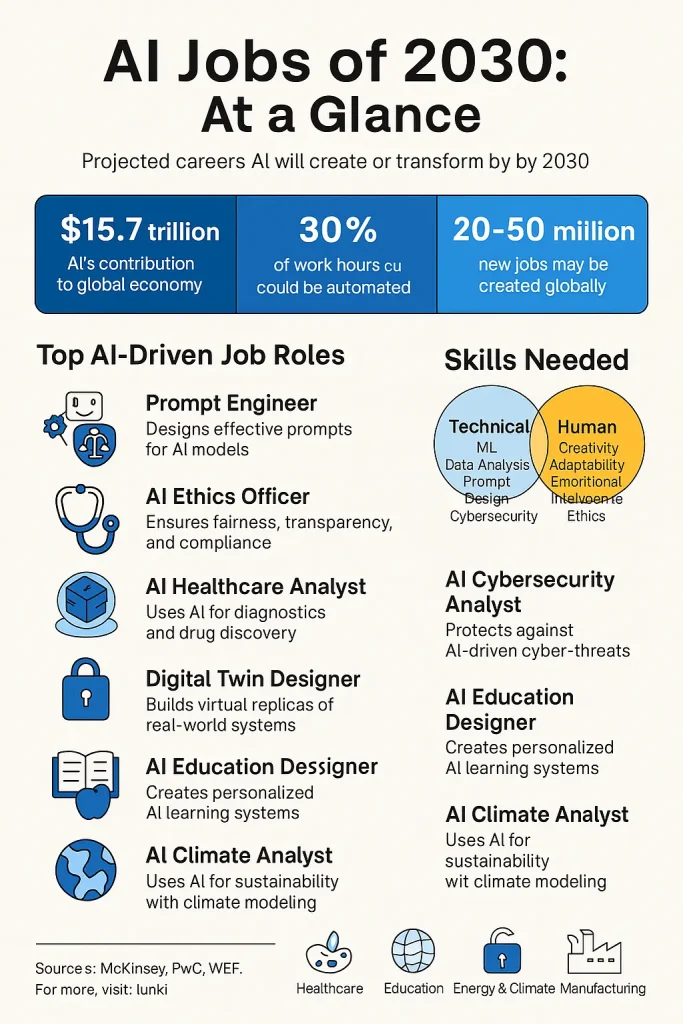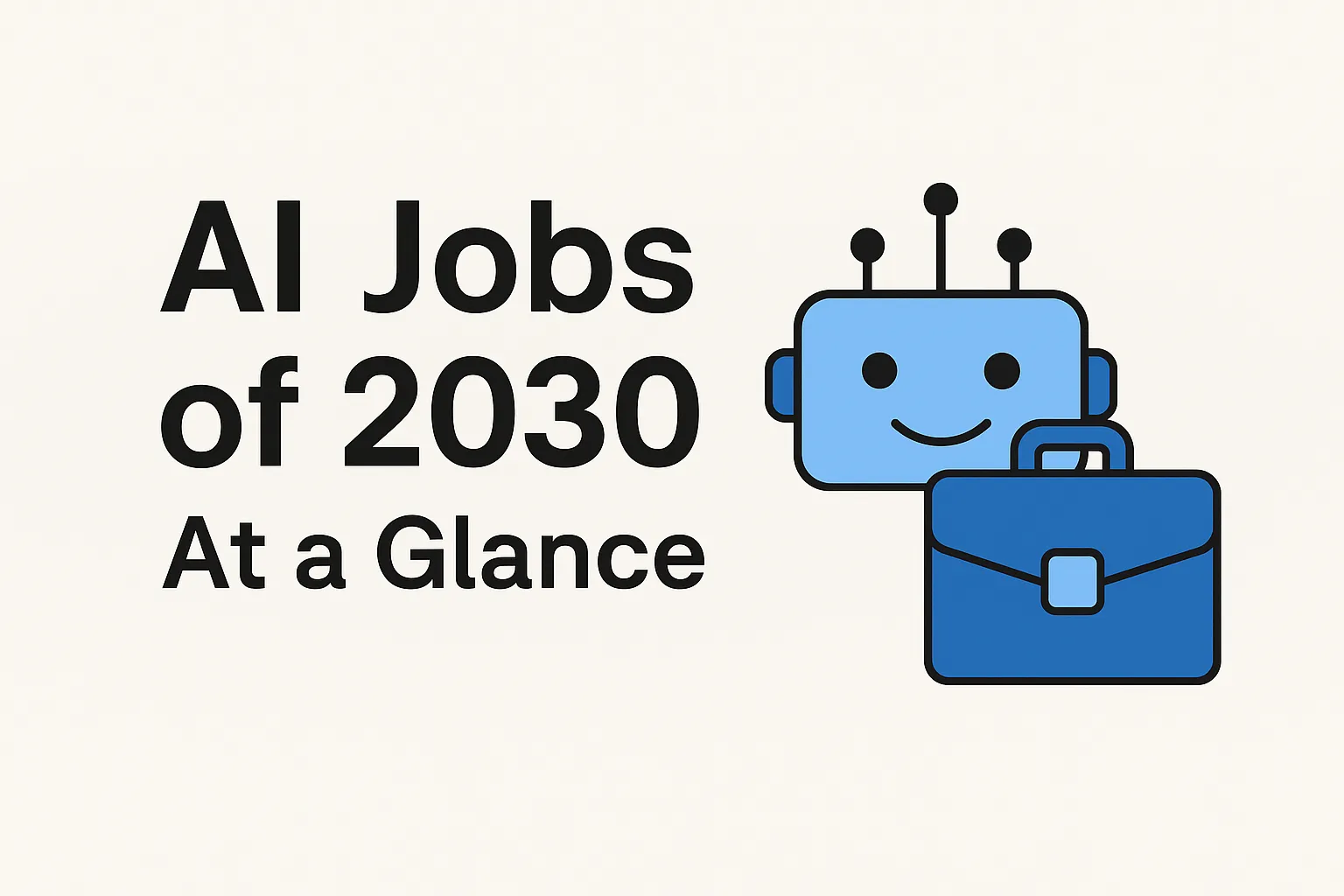Artificial Intelligence is no longer just a futuristic idea, it’s rapidly transforming how we live and work. By 2030, AI is projected not just to displace many tasks, but to create new job categories, shift skills demand, and redefine industries.
For policy makers, talent strategists, and individuals alike, understanding what roles will emerge could mean the difference between being left behind or being ready.
This article digs into what data currently tells us about the jobs AI is likely to create by 2030, the sectors that will see the most change, what skills will be essential, and what challenges we must navigate.
With this knowledge, educators, governments, and media outlets can reference it as a forward-look guide.

Table of Contents
Global Trends & Forecasts: How Many Jobs, and in What Shape
Before listing specific job types, here are some of the big-picture projections and trends that set the stage.
| Metric | What the Data Says |
|---|---|
| Jobs exposed to automation / AI | By 2030, up to 30% of hours worked in the U.S. economy could be automated due to generative AI and related tools. (McKinsey & Company) |
| New jobs created | McKinsey estimates that 20 to 50 million new jobs globally may arise by 2030 from AI adoption and related technology growth. (Nexford University) |
| Net effect | Some jobs will disappear or shrink, others will grow. Many roles won’t vanish entirely but will have parts of their tasks altered or automated. (McKinsey & Company) |
| Skill shifts | There’s increasing demand for more technical skills (machine learning, data engineering, prompt design) and human skills (creativity, adaptability, emotional intelligence). (Nexford University) |
| Employers’ behavior | Many companies are increasing investment in AI, but relatively few are “AI-mature” (i.e. having fully integrated AI in ways that reshape their business). (McKinsey & Company) |
Emerging Job Types: AI-Driven Roles Likely To Grow by 2030
Here are specific roles expected to emerge or expand significantly by 2030. For each, I include what tasks might look like, skills required, sectors likely to adopt them, and early signals.
1. Prompt Engineers & Generative AI Interaction Designers
- What they’ll do: Crafting and optimizing prompts for large language models or other generative AI; designing conversational flows; ensuring outputs are accurate, ethical, and aligned with user needs.
- Skills needed: Deep understanding of AI models, linguistics, human-computer interaction, UX design, ethics.
- Industries: Tech companies; content creation; marketing; virtual assistants; customer-facing automated systems.
- Early signals: Already, prompt engineering roles are being advertised with high salaries; businesses using LLMs are hiring specialists to supervise & refine them.
2. AI Ethics Officers & AI Governance Specialists
- What they’ll do: Establish policies and oversight for bias, fairness, compliance; ensure data privacy; audit AI systems; guide companies through regulation.
- Skills needed: Ethics, law/regulation, data policy, algorithmic fairness, risk management.
- Industries: Tech, finance, health care, government.
- Why important: As public & regulatory scrutiny grows, companies will need people responsible for ethical deployment, safety, transparency.
3. AI-Augmented Health & Life Sciences Specialists
These are not pure AI roles, but hybrid roles where AI amplifies human capabilities.
- Examples:
- AI diagnostic analysts (radiology, pathology) using AI tools to detect anomalies.
- AI‐assisted drug discovery data scientists.
- Personalized medicine specialists who tailor treatment via AI analytics.
- Skills: Bioinformatics, statistics/data analysis, domain knowledge (medical science), ability to work with AI tools & interpret their outputs.
- Sectors: Healthcare, pharma, biotechnology.
- Signal: Growing use of AI to speed up diagnostics, image analysis, clinical trial design.
4. Digital Twin Engineers / Virtual Simulation Designers
- What they’ll do: Build virtual replicas (“digital twins”) of physical systems—factories, supply chains, cities, organs—for simulation, prediction, optimization.
- Skills: Systems modeling, simulation, 3D modelling, IoT, data analytics, domain-specific knowledge (e.g. urban planning, manufacturing).
- Industries: Manufacturing, construction, smart cities, environmental planning, healthcare (e.g. organ simulations).
- Why needed: Helps test changes without real-world risk; optimize systems; improve efficiency; adapt to climate / infrastructure stresses.
5. AI Cybersecurity & AI Safety Specialists
- Role: Protecting systems that use AI; defending against AI-based attacks (deepfakes, adversarial inputs); ensuring robustness / adversarial stability of AI models.
- Skills: Cybersecurity, adversarial ML, model robustness, threat intelligence, AI safety research.
- Industries: Tech, defense, finance, government.
- Signal: Rise in AI attacks; more regulation; companies reporting more need for securing AI systems.
6. AI Education / Learning Designers & Trainers
- What they’ll do: Develop AI-driven adaptive learning platforms; design curricula that teach skills for working with AI; upskill/reskill existing workforce.
- Skills: Pedagogy, instructional design, edtech, AI tools, data literacy.
- Industries: Education, corporate training, government.
- Signal: Many learning platforms adopting AI personalization; increased investments in upskilling due to shifts in skills demand.
7. Climate-Tech & Sustainability Analysts Assisted by AI
- Roles: AI climate data analysts; AI planners for energy grid optimization; precision agriculture that uses AI to reduce waste; environmental risk modeling.
- Skills: Environmental science, data science, domain specialization (agriculture, energy), remote sensing, climate modeling.
- Industries: Agriculture, energy, municipal planning, conservation, start-ups focused on sustainability.
- Importance: Climate urgency + AI’s capability to analyze large datasets = big opportunity.
8. Creative + AI Fusion Roles
- Examples: AI music/video producers; virtual world / metaverse designers; interactive storytelling designers; generative content curators.
- Skills: Creativity, digital arts, content production, understanding of AI-generated media; sometimes technical skills for generative tools.
- Industries: Media / entertainment; gaming; advertising; digital marketing.
- Signal: Already seeing generative art, music, video tools being used by creators; some studios hiring for hybrid creative/AI roles.
Skills & Preparation: What Will Be Necessary in the AI-First World
To qualify for the roles above, or to transition into them, certain skills will become highly valuable.
Technical / functional skills
- Machine Learning / Deep Learning fundamentals
- Data analysis, data engineering, data infrastructure
- Prompt engineering / conversational AI design
- Model evaluation, fairness, bias detection
- Cybersecurity, AI safety
Human / soft skills
- Adaptability & continuous learning
- Emotional intelligence, collaboration
- Creativity & design thinking
- Ethical reasoning
Education & credentials
- More emphasis on skills over formal degree, micro-credentials, bootcamps, certifications. There are indications employers increasingly accept or prefer demonstrated skills rather than strict degree requirements for many AI roles. (arXiv)
- Lifelong learning will be necessary.
Other environment factors
- Infrastructure (data, compute) to support AI tools in various geographies.
- Regulatory frameworks for privacy, safety, ethical use.
- Public policy & investment in retraining / upskilling.
Challenges & Risks: What Could Go Wrong
No forecast is perfect. Here are pitfalls and risks to address, to make sure AI job creation is broad, equitable, and sustainable.
- Job displacement and inequalities
Many existing roles (especially repetitive, low-skill, clerical, customer support, etc.) are at risk. Workers in those roles may not easily transition without support. (McKinsey & Company) - Skills gap
There may be a shortage of qualified people for new roles, especially in regions with less access to tech-education. - Geographical disparities
Adoption rates and infrastructure differ by country; some regions may benefit more, others lag. - Regulatory & ethical issues
Risks from bias, data misuse, algorithmic harm. Also, privacy concerns as AI systems become pervasive. - AI maturity
Though many companies are experimenting, few are fully mature; scaling AI safely and effectively is non-trivial.
Early Signals & Case Studies
These help show that many of the jobs listed above are not just hypothetical — the beginnings are visible now.
- Large firms investing in AI ethics / governance teams.
- Hospitals using AI tools for diagnostics.
- Educational platforms employing AI-based personalization.
- Tech companies explicitly hiring prompt engineers / AI interaction designers.
What to Do Now: Roadmap for Individuals, Institutions, News Agencies
| Stakeholder | Immediate Actions / Strategies |
|---|---|
| Individuals / Workers | Begin learning skills mentioned above; take online courses; build small AI-tool projects; be flexible about changing roles. |
| Educators / Universities | Update curricula to include ethics, AI tool use; partner with industry; offer accessible skill-based credentials. |
| Government / Policy Makers | Invest in retraining programs; incentivize ethical AI development; ensure access to infrastructure / broadband / compute. |
| Businesses / Employers | Start classifying tasks (not just jobs) that could be automated; build AI maturity; ensure human-AI collaboration; focus on fair hiring. |
| Media / News Agencies | Use and share data; highlight regional / industry-specific stories; call attention to both opportunities and risks; use visuals (charts, predictions). |
Conclusion: Human + Machine: The Partnership of Tomorrow
By 2030, AI is likely to have transformed entire swathes of work. Yes — some roles will shrink or disappear. But many more will emerge that we can hardly imagine today. These emerging jobs will often sit at the intersection: human values + AI power.
The future will favor those who adapt. Those who can learn, who can think critically and creatively, who can partner with machines rather than compete with them. For news agencies looking for stories, for job seekers thinking about tomorrow, and for policy makers needing to plan — this shift is happening already.
